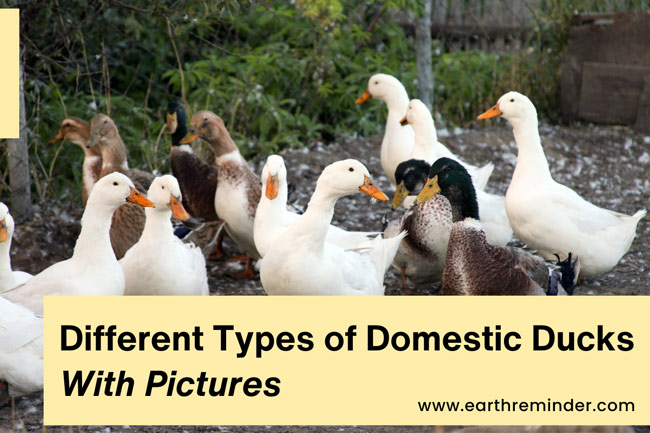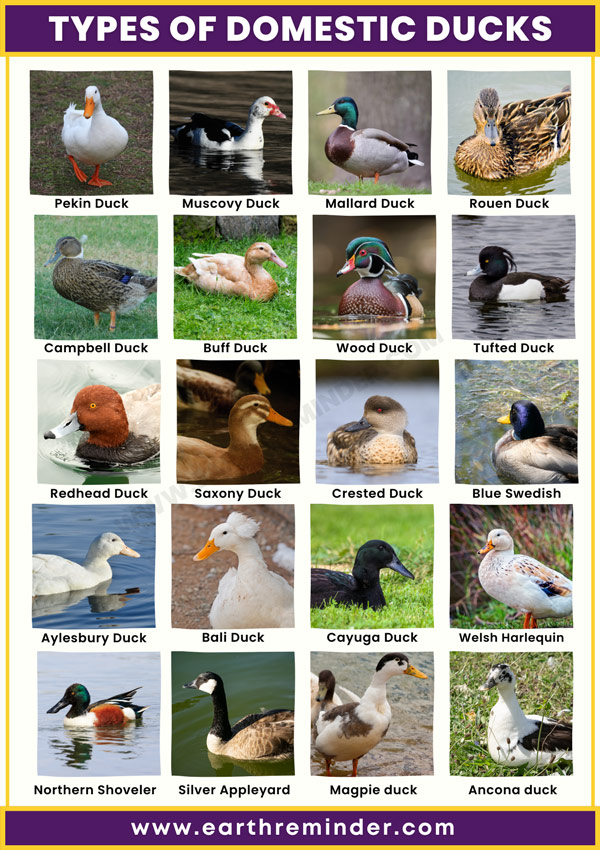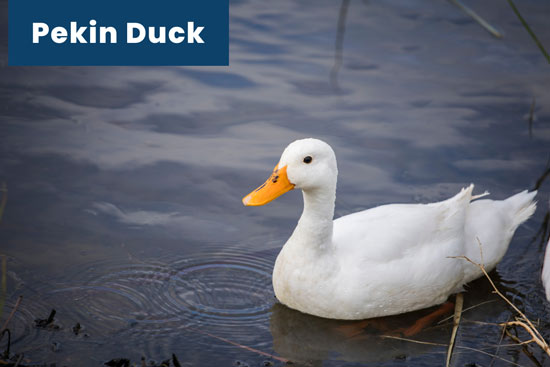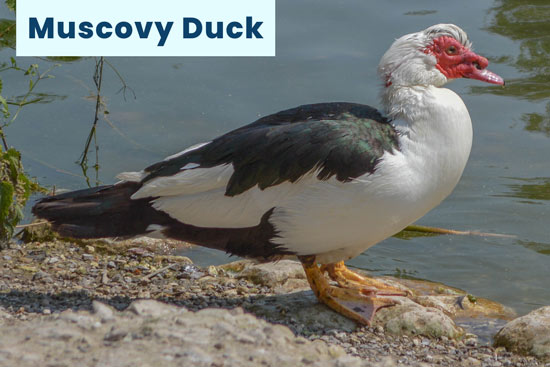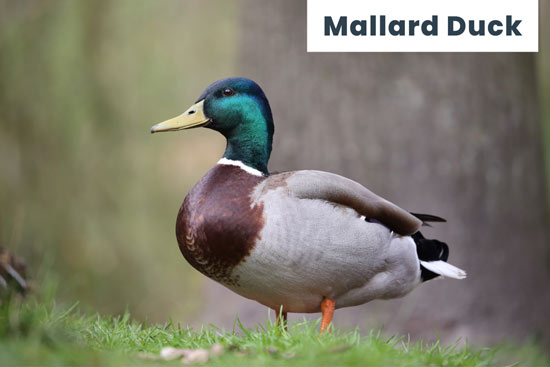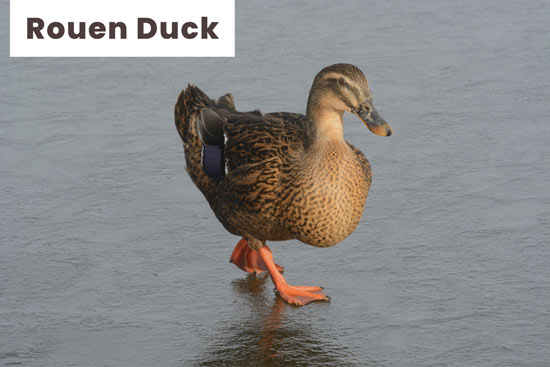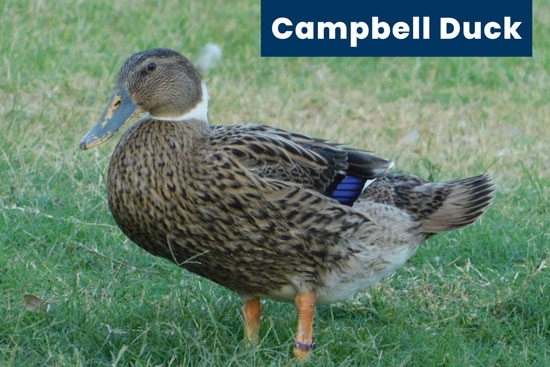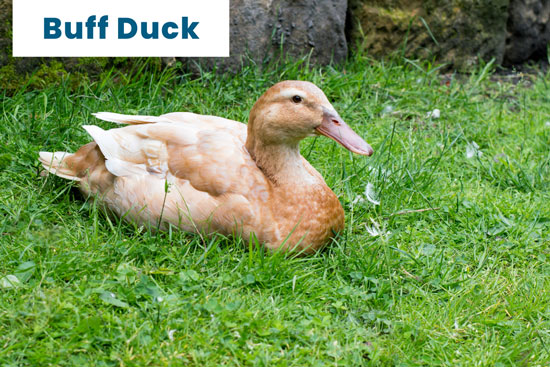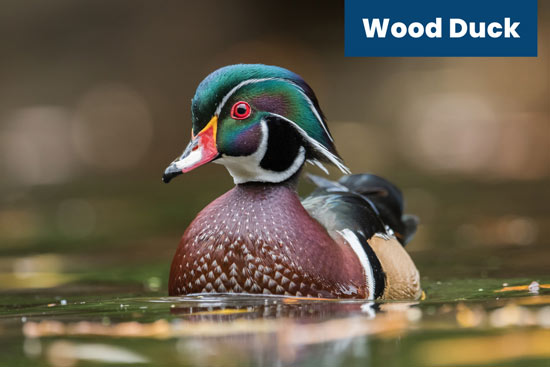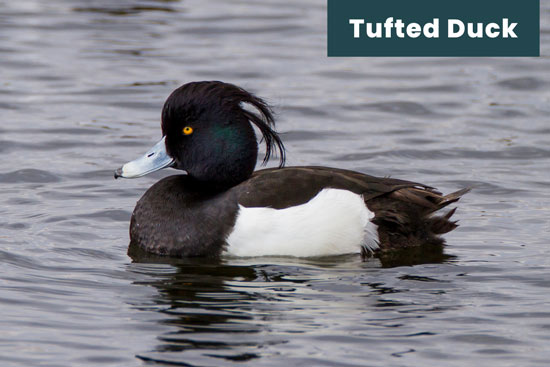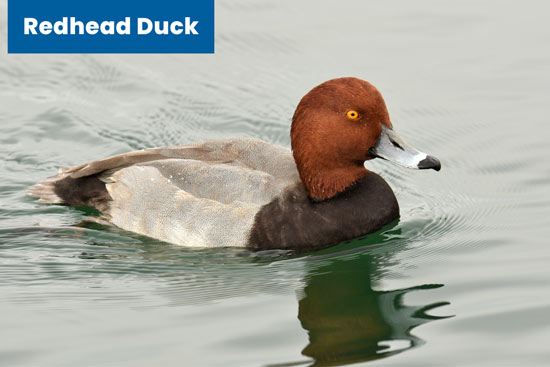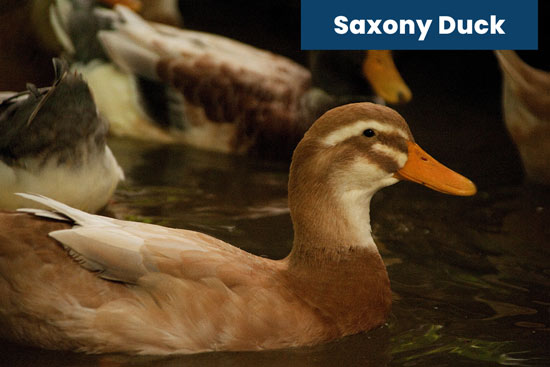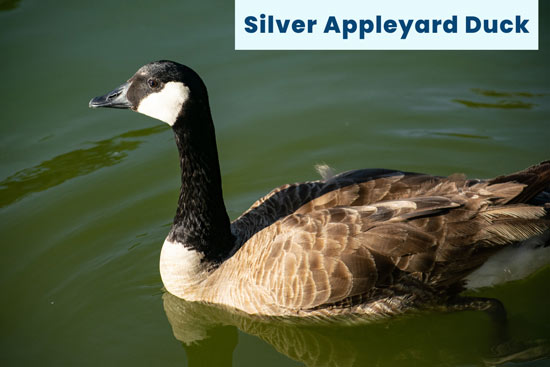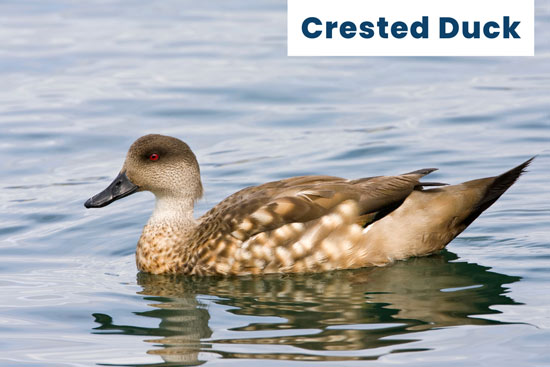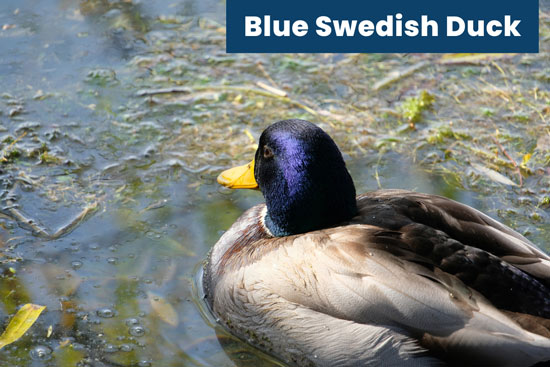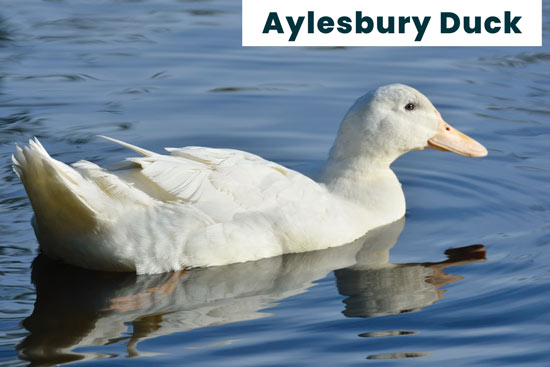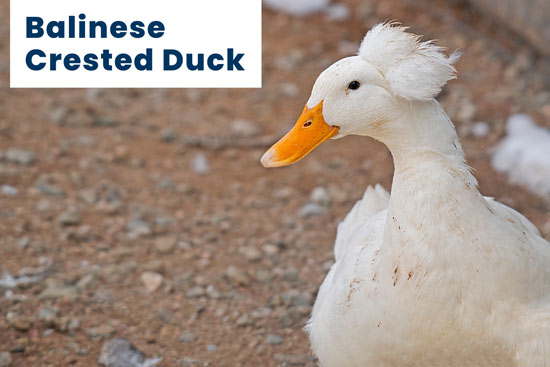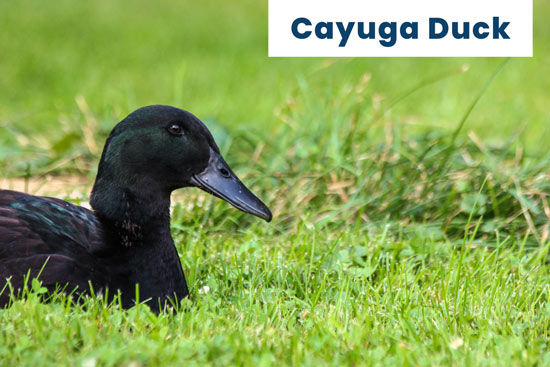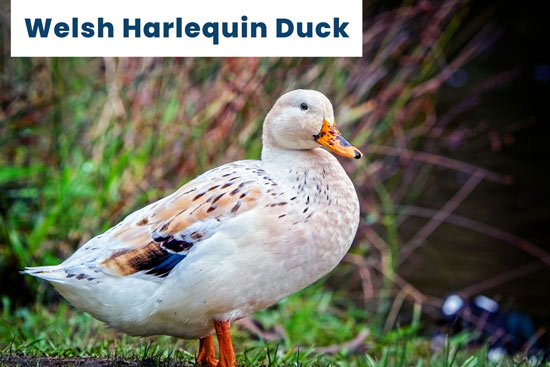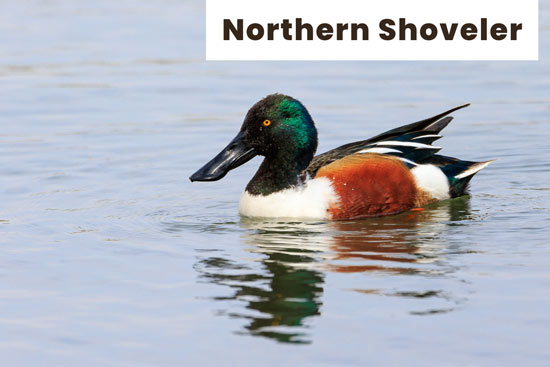18 Different Types of Domestic Ducks With Pictures
Domestic ducks, commonly referred to as farm ducks or backyard ducks, are a well-liked and adaptable breed of poultry that humans keep for various uses. Since ducks have been domesticated for countless years, they are frequently seen in backyards, farms, and homesteads. They are known for their webbed feet, chubby bodies, and unusual bills. Every duck has its own qualities and benefits, and they come in different sizes, shapes, and colors. These ducks provide multiple functions in human culture, from being lovely pets to being ornamental birds and a sustainable source of meat and eggs. Understanding about different types of domestic ducks can help you choose the right one for your needs.
Table of Contents
- 1 Types of Domestic Ducks
- 1.1 Pekin Duck
- 1.2 Muscovy Duck
- 1.3 Mallard Duck
- 1.4 Rouen Duck
- 1.5 Campbell Duck
- 1.6 Buff Duck
- 1.7 Wood Duck
- 1.8 Tufted Duck
- 1.9 Redhead Duck
- 1.10 Saxony Duck
- 1.11 Silver Appleyard Duck
- 1.12 South American Crested Duck
- 1.13 Blue Swedish Duck
- 1.14 Aylesbury Duck
- 1.15 Balinese Crested Duck
- 1.16 Cayuga Duck
- 1.17 Welsh Harlequin Duck
- 1.18 Northern Shoveler Duck
- 2 Conclusion
Types of Domestic Ducks
Due to their friendly nature and numerous benefits, such as eggs and pest control, domestic ducks are a popular choice for pets and farm livestock. There are several species of domesticated ducks, each with their own distinctive characteristics and purpose, and here are 18 of them, with detailed descriptions and pictures to help you identify them:
Pekin Duck
Scientific Name: Anas platyrhynchos domesticus
One of the most widely recognized domestic duck breeds is the Pekin. The Pekin or White Pekin is a domestic duck breed raised in the US mainly for its meat. It originated from birds that were transported from China to the United States during the nineteenth century and is currently bred worldwide.
Pekin Ducks have massive, hefty bodies, making them lousy flyers, though they have strong wings and hollow bones like other duck species. Contrary to having teeth, ducks filter food from water using serrated edges on their bills, known as lamellae. Vegetation, fruits, seeds, grains, and diet are the leading food of Pekin duck.
Muscovy Duck
Scientific Name: Cairina moschata
The Muscovy duck is a rare kind of duck recognized for its striking appearance. They have a warty neck, a face devoid of feathers, having a variety of colored plumage. To see a Muscovy Duck across its natural environment, travel to the Rio Grande Valley in Texas, the forested wetlands throughout Mexico, or the tropical Americas. The Rio Grande in Starr County, along Falcon Dam and Roma, has the most significant concentrations in the United States.
The brilliant red caruncles that cover their eyes and the area above their beaks make Muscovys distinctive. Although they have less developed oil glands than most ducks, they do not swim much. The primary food sources for Muscovy ducks are plants, worms, insects, mollusks, tiny fish, and even reptiles. Being omnivores, they eat animals and plants at all life phases, from seed to nut and egg to adult.
Mallard Duck
Scientific Name: Anas platyrhynchos
Mallards are among the most widespread and recognized wild ducks across the Northern Hemisphere. The mallard can be found in a variety of habitats, even climatic regions, including subtropical even Arctic tundra. This species inhabits both saltwater and freshwater environments, including parks, ponds, rivers, lakes, estuaries, and shallow inlets.
During the breeding seasons in spring and summer, male Mallards display distinctive, colorful plumage to attract females. Small fish, grains, and various plant materials are all consumed by mallard ducks. Although they are omnivores, they choose plant material over animal-based foods.
Rouen Duck
Scientific Name: Anas platyrhynchos domesticus
The Rouen Duck is a distinguished breed named after the French city of Rouen, where it was first raised. Originally from France, Rouen ducks gained prominence after being introduced to England, where they were further refined. Their resemblance to Mallards in coloration often leads to confusion, although wild Rouens are generally leaner compared to those raised on farms. Rouen Ducks feed on a variety of aquatic life, including small fish, snails, crabs, and larvae or pupae typically found under rocks.
Campbell Duck
Scientific Name: Anas platyrhynchos domesticus
One of the most popular domestic breeds in the US represents the Campbell duck. The Campbell is a domestic duck breed from Great Britain. Developed in Uley, Gloucestershire, England, at the turn of the 20th century, the Campbell was made available to the public in 1898, with the Khaki variation following in 1901. As ducklings, they can be fed non-medicated chick starter feed, and after reaching three months of age, they may be switched to waterfowl, game bird, or chicken feed.
Buff Duck
Scientific name: Anas Platyrhynchos domesticus
The pleasant and docile Buff Orpington duck is a versatile breed of poultry bird. The Buff Orpington duck is a breed that originated in England. William Cook, a well-known poultry breeder from Orpington, Kent, is recognized for developing this type of duck. It was first introduced in the late 1800s.
This breed features a broad body, an oval head, a medium-length bill, and an elegantly curved neck. The Buff duck has tiny, curving wings and carries its body 20 degrees angle horizontally. They thrive in a free-ranging foraging environment, eating worms, insects, small fish, plants, seeds, and more.
Wood Duck
Scientific Name: Aix sponsa
Belonging to the Anatidae family, the Wood Duck, also known as ‘woodie’, is a small, colorful North American perching duck and a well-liked game bird. These birds are typically found in wooded swamps, where they nest in tree hollows or in nest boxes placed along the edges of lakes.
The Wood Duck is one of the few duck species able to perch on branches, due to its strong claws that can grip or hold bark. Their diet consists of plant material, seeds, nuts, and various invertebrates found both on land and in water.
“Domestic ducks offer unique benefits in our daily lives, but they are part of a broader family of domesticated animals that impact us in various ways. Discover the importance of domestic animals in our lives.”
Tufted Duck
Scientific Name: Aythya fuligula
The Tufted Duck, a medium-sized diving duck, is slightly smaller than the Mallard. Adult males display a black head, neck, and back, with contrasting white flanks. Ducks, also known as ‘waterfowl’, typically inhabit wet environments such as ponds, streams, and rivers.
Tufted Ducks have a lifespan that generally ranges from 5 to 10 years, although some individuals may live longer if they are properly cared for. Their diet primarily includes aquatic insects, mollusks, and plant material, sometimes feeding on small fish and roots.
Redhead Duck
Scientific Name: Aythya americana
During the winter, the stunning Redhead Duck can be seen in large groups numbering in the thousands on lakes and bays. Males are recognizable by their cinnamon-colored head, yellow eyes, and dark gray body.
Redheads primarily breed in seasonal wetlands, such as the prairie pothole region of the Midwest. During migration and particularly in winter, they gather in enormous flocks along the Gulf Coast, the Great Lakes, and bays and beaches throughout the southern United States. Their diet primarily consists of leaves, tubers, and other vegetative parts of submerged aquatic plants.
Saxony Duck
Scientific Name: Anas platyrhynchos domesticus
Saxony ducks can make ideal pets because they are friendly and exciting. Their down and feathers are highly valued and often used in making pillows and other bedding products. The Saxony Duck originated in Germany and specifically developed in the Saxony region. They are renowned for their beautiful appearance and calm, docile nature.
Saxony ducks are distinctive for laying large, white eggs, a trait that sets them apart from many other duck breeds that typically lay brown eggs. Unlike many duck breeds that produce brown or tinted eggs, Saxony ducks consistently lay white eggs. Saxony ducks have a varied diet that includes seeds, insects, and aquatic plants, showcasing their adaptability in different ecosystems and environment.
Silver Appleyard Duck
Scientific Name: Anas platyrhynchos domesticus
The Silver Appleyard Duck is a large and robust breed, known for its excellent meat quality and prolific nature. Their distinctive yellow or greenish bills and orange legs contribute to their striking appearance. Reginald Appleyard, a renowned poultry breeder, developed the Silver Appleyard Duck in the 1940s at Priory Waterfowl Farm in Suffolk, alongside other breeds like the Ixworth chicken.
The Silver Appleyard Duck’s diet includes a variety of foods such as grains, alfalfa, insects, aquatic organisms, and grass, reflecting their foraging nature. In addition to requiring access to clean drinking water, Silver Appleyard Ducks are particularly fond of consuming slugs and snails.
South American Crested Duck
Scientific Name: Lophonetta specularioides
While Crested Ducks are not primarily bred for meat, they are popular as pets due to their distinctive appearance and friendly nature. Crested Ducks are native to South America and have not historically been documented as originating from the East Indies.
While they are well-regarded in their native range, there is no significant historical record of them being used as livestock by European farmers. Crested Ducks typically forage by dabbling in shallow water for mollusks, insects, and insect larvae.
“As ducks are aquatic birds, check here why birds are important to the environment.”
Blue Swedish Duck
Scientific Name: Anas platyrhynchos domesticus
The Blue Swedish Duck is well-suited to cold climates and is known for its hardiness. The Blue Swedish is a prominent domestic duck breed in Sweden. This breed originated in the nineteenth century in Swedish Pomerania, now part of modern northeastern Germany and northwest Poland.
The Blue Swedish Duck is noted for its striking blue plumage and a distinctive white bib that extends from under the bill to the middle of the breast. Additionally, they feature white patches on their wings, which contrast beautifully with their blue plumage.
Blue Swedish Ducks excel at foraging and thrive in environments where they can roam freely. Their diet typically includes plant material, insects, and various bugs, supplemented with additional suitable foods like grains and greens for optimal health.
Aylesbury Duck
Scientific Name: Anas platyrhynchos domesticus
The Aylesbury Duck, often referred to as the English duck, is one of the oldest breeds still favored by contemporary farmers. Originating from Aylesbury in Buckinghamshire, England, this breed is known for its meat production and distinctive appearance. The Aylesbury Duck’s diet primarily consists of small fish, snails, crabs, and larvae and pupae of various aquatic organisms.
Balinese Crested Duck
Scientific Name: Anas platyrhynchos
Originating from Bali, Indonesia, the Bali Duck, also known as the Balinese Crested Duck, is a stunning and ancient breed of domestic duck. While the Bali Duck is primarily raised for its ornamental value and as pets, it is also known for its good egg-laying capabilities, producing 120-250 eggs annually.
Compared to the Indian Runner Duck, the Bali Duck features larger shoulders, a heavier build, and a more robust head and bill, distinctively marked by a crest on its head. Bali Ducks are herded into fields before harvest, where they contribute to pest control by consuming algae and insects and fertilizing the soil with their droppings.
“As these ducks are domestic birds, check out these different types of domestic animals.”
Cayuga Duck
Scientific Name: Anas Platyrhynchos
Cayuga ducks are celebrated for their unique egg coloration, though they taste similar to chicken eggs, offering a richer and more luscious profile. Native to the United States, the Cayuga Duck originated around Lake Cayuga in New York and is known for its striking appearance.
Cayuga ducks are energetic foragers, primarily feeding on insects, slugs, and snails, making them excellent at pest control. Their heavier weight limits their ability to fly, making Cayuga ducks less likely to stray far from their home.
Welsh Harlequin Duck
Scientific Name: Anas platyrhynchos domesticus
The Welsh Harlequin Duck, known for its unique appearance, was developed in Wales. It is a distinguished breed of domestic duck. Welsh Harlequins are skilled foragers who adore eating pasture greens, including insects. Their diet should also include a well-balanced duck feed as a supplement to ensure optimal health.
Northern Shoveler Duck
Scientific Name: Spatula clypeata
The name ‘Northern Shoveler’ aptly describes its feeding behavior; this duck uses its large, spoon-shaped bill to sift through mud, filtering out food. After breeding in northern Europe, the Palearctic, and much of North America, Northern Shovelers winter in southern Europe, the Indian subcontinent, and other warm regions.
The Northern Shoveler is considered a rare vagrant in Australia. Their uniquely shaped bill is perfectly adapted for extracting small aquatic creatures from the water. Northern Shovelers have comb-like structures on the edges of their bills, allowing them to filter microscopic crustaceans, aquatic invertebrates, and seeds from the water.
“When compared to domestic ducks, wild ducks have a different natural diet. Learn what wild ducks eat and drink in detail.”
Conclusion
To summarize, there are lots of different kinds of domestic ducks out there. Each type has its own special qualities. Domestic ducks are intriguing animals humans have domesticated for various reasons. They are noted for their distinctive traits, including webbed feet, waterproof feathers, and the majority of bills, and come in multiple breeds, sizes, and colors. Whether you want a duck that lays lots of eggs, one that’s good for meat, or just a friendly pet, there’s a type of domestic duck for you. They’re not just useful, they’re also fun to have around and can make great companions.
